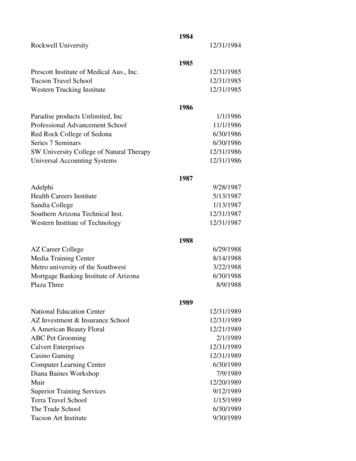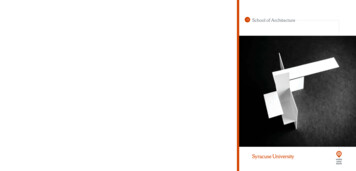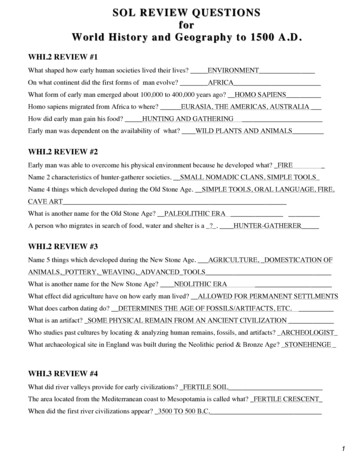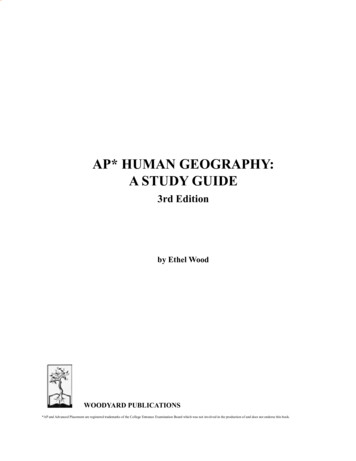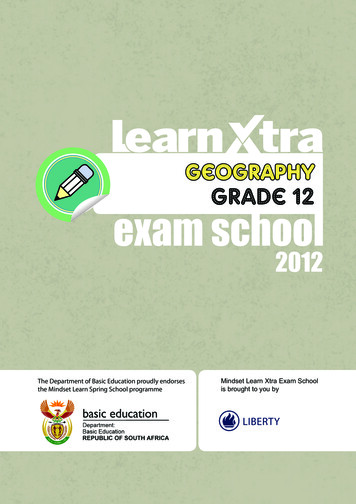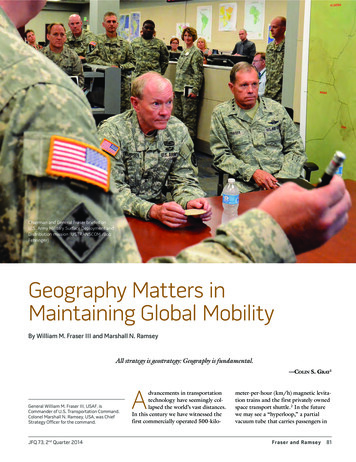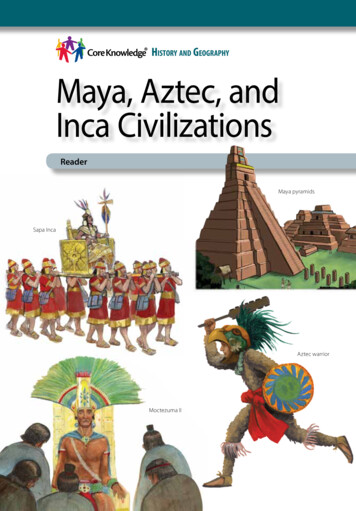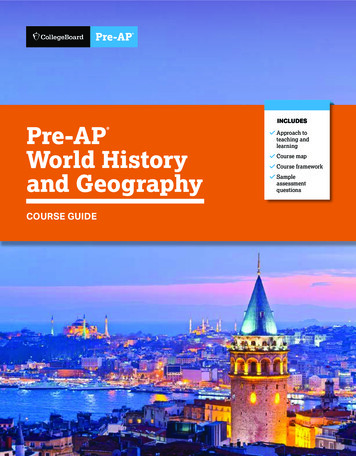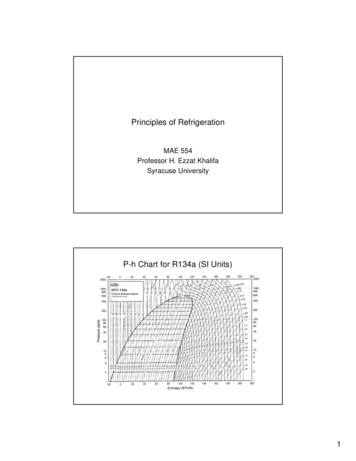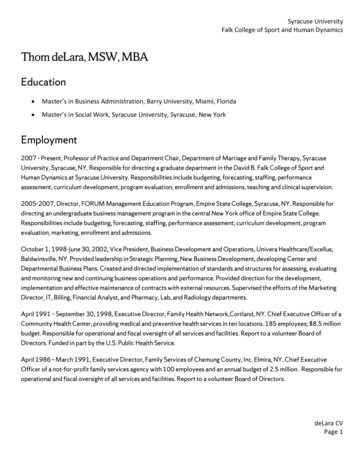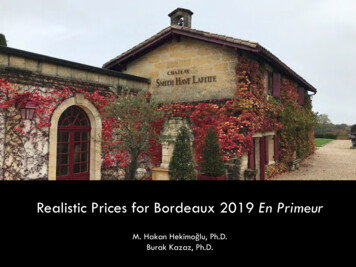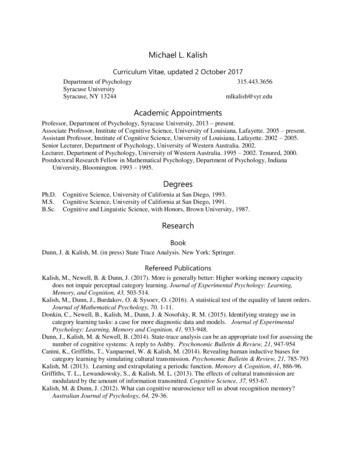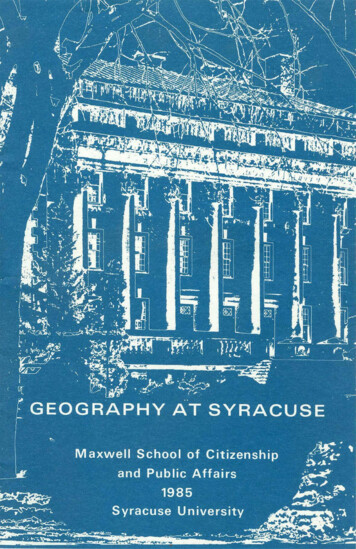
Transcription
Maxwell School of Citizenship and Public AffairsSYRACUSE UNIVERSITY1985
CONTENTSGeography at Syracuse . Syracuse Geography in National "Top Ten". . . . .The Undergraduate Program l)eath of David E. Sopher . David E. Sopher Memorial Scholarship . News from the Department .Chairman Jens en enters Third TermNew Faculty Faculty promotions. New James Library dedicated 2 3 4 8 10 10 Geography projects. New link with London School of Economics.Retirement of John H. Thompson. Departmental publications Visiting Speaker Program1 .Geography Colloquium. . . . . . . . . . . . . . . . .Geography Symposia. . . . . . . . . . . . . . . . . .Cressey-James Fund .10121515212222262630 35Graduate Degrees Granted in Geography. 37 41 43 The Recent Placement Experience of SyracuseGeography Graduates: Some Facts and Figures.Faculty and Staff .
Graduate Students in Residence . 57Alumni and Non-Resident Graduates. 68List of Geography Alumni . 131 136A Final Note .
GEOGRAPHY AT SYRACUSEThe Geography Department at Syracuse University is locatedin H.B. Crouse Hall on the edge of the central campus quad-rangle.It provides easy access to the University's BirdLibrary, the mainframe and micro-computer centers, and otherkey university buildings.Within H.B. Crouse the Departmentcontains offices for faculty and graduate students, the newPreston E. James Library, classrooms, seminar rooms and spacefor terminals that allow direct access to the University's com-puter system.Since Bird Library has, since 1979, progressively transformed its card index of holdings to a computerizeddata base, this means that Geography students can now searchfor bibliographic items via the flexible interactive SULIRSsystem from departmental terminals.Recent advances in micro-computing are also affecting theDepartment.We are in the process of establishing a small com-puter graphics laboratory, and have recently purchased our firstIBM/PCXT for use in departmental editorial and office work.As will be described below, the Department has seen manysignificant changes over the last five years. Some researchinterests have been strengthened and others enhanced by newdirections stimulated by the changing faculty and students.These new directions at Syracuse reflect deeper processesaffecting both geography and the social sciences in general.Typical new foci of concern include environmental/ecologicaland degradation; public and private institutionalstability responses to changing industrial patterns within developedcountries; the changing internal structure of United Statesmetropolitan areas and the complexities of socio-ethnic cleav-ages and gentrification; the renewed significance of geopolitics at the international level and political separation withinnation-states; the impact of technological change on the analysis and presentation of spatial data; the potential and problems associated with international development projects inII
2Third World areas--these are iust some of the new concerns thatdiversify and enrich contemporary geography at Syracuse.An increasing concern is also to provide graduates with abalance of intellectual and professional/vocational skills thatwill assist them in finding a place in the increasingly difficult job-market.The days when a good dissertation ensuredentry into an expanding university workforce are gone; nowmore and more graduates must consider other career opportunities and requirements as they move through the program.Other important changes in the department have been thesteady increase in the relative proportions of women graduatestudents, and students from outside the United States.Theformer reflects the belated 'opening' of the discipline duringthe last decade, while the latter may be seen as a response toSyracuse's international interests and reputation. Bothchanges are welcomed for they have invigorated our endeavorsand extended our collective horizons.Syracuse Geography in National ''Top Ten''The 1982 Report of the Conference Board of AssociatedResearch Councils, An Assessment of Research Doctorate Pro-grams in the United States (Washington: The National ResearchCouncil), provides information on a number of reputational andobjective measures of graduate program quality which allowsdepartments to see themselves as they are seen by others.Coverage of the report in the New York Times and the Chronicleof Higher Education listed Syracuse as one of the "top ten"Geography Departments in the United. States in terms of two keymeasures- -Reputation (9tl1) and Publications (8th) . The ful 1report, however, provides data on 18 measures.We haveanalyzed those data and by using a composite measure find thatthe department is regarded even more favorably (6th) thansuggested by the two measures reported in the press.TheNational Research Council also reports that the overall qualityof the geography program at Syracuse is seen to be improvingin the eyes of peer evaluators.We have, of course, been
3working in that di1:ection, and we hope that this issue ofGeography at Syracuse provides evidence of a continuing tradi.tion of excellence expected by our graduate alumni.The Undergraduate ProgramSince our last report to the alumni, undergradua·te enroll-ment in GeograpJ1y has increased by about one-third. Thedepartment has taken a number of steps to insure that thispositive trend will continue in the years ahead. In responseto strong interest among Freshmen and Sophomores in depart-mental offerings featured in the Liberal Arts Core (The Standard Plan), we have decided to offer several of these "gateway"courses twice each year in order to reduce scheduling problemsfor students.Because exposure to the discipline has createddemand for more advanced work, the department now provides aminor option which allows Juniors and Seniors in other departments to focus their geographic study within one of fourtracks: Core Concepts, Environmental, Locational and RegionalAnalysis, and Population. These minor options also representpossible areas of specialization for geography majors.Inaddition the department undertook an "outreach" effort whichhas resulted in several geography courses being highly recom-mended by the School of Management, the College of Environmen-tal Sciences and Forestry, as well as by other Maxwell Programsincluding International Relations, and Policy Studies.An important departmental objective for the next fiveyears is to sharply increase the number of undergraduatemajors.We will of course report the results of that effort inthe next issue of Geography at Syracuse.
4DEATH OF DAVIDE. SOPHERThe Department suffered a terrible loss with the death ofDavid Sopher on March 8, 1984.He had been under treatmentfor cancer for three years but with characteristic quiet dig-nity and courage had simply carried on his work and told noneof his colleagues about it until well after it had becomeapparent that he was seriously ill.Once his condition becameknown there was a wonderful spontaneous response from his for-mer students and friends.Many came to see him, others tele-phoned, letters and cards came pouring in providing vividtestimony of how much this remarkable man had meant to so manypeople around the world.David Sopher was born in Shanghai in 1923.His parentswere of the Baghdadian Jeivry and he lived in Shanghai untilafter World War II when he came to Berkeley and obtained hisuniversity degrees in geography.He taught briefly at theUniversity of Minnesota, served as Research Associate at theAmerican Geographical Society, and was teaching at SacramentoState in 1964 when he accepted the invitation to come toSyracuse to fill the position left vacant by the death ofGeorge Cressey. Syracuse gave David the opportunity to undertake syste-matic study of the incredibly complex human geography of Indiaand to extend his work broadly in Cultural Geography.Hisbook Geography of Religions (1967) was the first general workon the topic in English and will long remain a landmark in agrowing field.He served as map editor and worked closelywith his onetime Syracuse colleague Isma'il Ragi al Faruqi tocreate the great reference volume Historical Atlas of theReligions of the World (1974). The book An Exploration ofIndia, Geographical Perspectives on Society and Culture (1980)is a fine exhibit of the close collaboration between David andhis students but it is no more than a hint at the range anddepth of his in1pact. He served as principal advisor on
5David E. Sopher 1923-1984II
'State of New YorkLegislative ResolutionSenate No. 584SY: Se n tor Auer 2 RESOLVED, Th a t thi s A s s embled Bo d y e,cpre,:ss its sine.cre s t co n dolenu s tohi s f.amlly a nd frie n ds.; a nd b it furtherRESOLVED, That copie s of this Resoluti on , s uitably e n 9ros s e d, betr.an s mitted to hi s widow, Tre s s a, an d th e Depa rtmen t o f Geography at S y r aeu nUn ive rs ity .AOOPTEO IN SENATE ONMaf'Ch 2.1, 1984COMMEMORATING the de.ath of Or. David E.S09her\.WHEREAS, This legi s lative Bod y wH s addened to lea rn of the dHth of Or,David E. Soph e r on Th u r s da y, M.&r-ch e ighth , n inete e n hu n d r e d el g hty fou r ; a n dWHEREAS, Da vid Sophe r w.u bo r n and r.1i sIn Sha n g ha , Chi n a anded u cated at th(!; Unive r sit y of Califo r n ia at Be r ke ley whe re hei r ec eived his.bache-lor' , master' s an d doctorate deg r ees in geograph y in nl n etee ri h1.1ndredforty eight, nineteen hu ndl'ed fifty 11nd nineteen hundred fifty fourrespectivel y ; andWHEREAS, Or . Oavid Sopher Ul"Ved u a Research Auoelate with th Am e r iu n Ge o g r ap hic.a l Soc ie t y and bu9ht at th e Uni v ersity of MiInrn e sota;,Sacr a me nto State Co l e9 e, an d the Un ive r s ity o f Chic.ag o pri o r to hi s arrival atSyr.aeuso Univ e rsity In nineteon hundred ixt y - fo u r; andWHEREAS. Or, Soph r d e vo tt t twent y y c.a,r s o f hi s life te,1chin 9 as ,1Prof e u or o i Ge 9ra phy i n th e Mtixwe ll School at Syr.ac:use Univ e rsity wher e hea chiev &d internation a l .acc.laim fo r hi s cholarly s tu dies o f th e cultur e s andreli g ion &of th e world and n s pec.i \llis t in Asi.an s tu die s ; andI l n ished tind le IWHEREAS, Or. David Sophe r 's qu e st tor kno wledge n ever dimito uten s ivo resHrch in lndi,i, P.aki s t.an, 8.tngladesh, Sri L.a n ka nd En9l,1ndwhi (. h wn s upportod b y th National Sc ien ce Fou n d tilon, the Office o f N.avalfRe s e .arch, Syrac. u s e Univer s ity , and a Fulbright Fellowshlp;.and' .s thoorotic.al exp e rti s eWHEREAS, These fi e ld studi es combi n ed with 0,1vid'and i n novativ e inteUectprodu c ed n ume rous profeui o n a l artiI c.Ilo s , no tably "An""Exploration of India an d "Th e S u Nom.ad s: · , ;) n d hi . la n dma rk book 'lltoGeo gr aphy of Religion s ; ,1n dWHEREAS, Or. D vld Sopher on«l\lr g e d tho advanctment o f s ehoIla rIl ys tudie s at Syr c u ui Un i versity through hi s position as editor o f the s,-ueu s oSc bol4r an d th Oep.artment o f Ge,ogra ph y Di s c us sio n Pap e r Serle s ; indWHEREAS. In hi s commitme n t to eonvnunkate th n1tuf'O o f geogr.aph y .i n d sint e rdis cip linary att r ib u tes ho s erved u a vi s ici n 9 Prof es s o r at th e University ito fCa.lifor n ia and the Hebrew Un lver slty of Jor1.1nlcm and H ,11n a ctive member o f th eA s s ociatio n fo r Asia n St u dlt t, th e Auoc.i,tiIo n o f Ame r ic.a n Ceographer s , th eAmerican Geogr,1phi(: a l Societv, a nd the MiddlI e Eut Dialogue Cro u p; an dWHEREAS. Or. David Soph e , .·s e frting o f th e cartogr.1phlc pr e:sen ta tio ns inthe Hhtode.1 At.las ot th Re l i gi0ll o ! tM Vorld nd his co. e d!tor-ship o f thofor'theomtn9 book Th City if\ CUltutal Context ar e two o f m,1ny ex.am.pie s whic:hdepic t th e ad·mintion nd ro s p e;t ho engendered amon 9 hi s pur ; andWHEREAS, Or . Sopher" s c;o.n trlb u tion in upholdl n 9 and e.n h an c ing thett'a dition and nati on i l r-en-own of the Oepartm e n t of Geo g raphy at S y r acu s eUniver s ity was in e .stim.able; andWHEREAS, Or . David S s he r · s most profo u nd infl u e nee in e n lightening ande x p.an di n g th e global s erspectlves o f hi s numer o u s u ndergr adu1te ind gr du t s tu de n t s will re v e rberate throu9h f u tur g nor.ati o n s ; an dWHEREAS, The aceompli s hmen b o f tho life of David E. SoPher a s schoJ1r an d a hu man i n g will be i n e ru e ,1bly e tc hed in the me mories of his hrnily,f r ie n ds. eoflugues. a:nd stud e n ts who h.id the g ood fortune to C lffle into cont.ictwith him; now, th e f'IClfo ro, be itRESOt.VEO. That thi s Legi s lat ive Bod y p,1u s e in its d e libe ration s toa cknowle dge th e lif e ;md Clrffr o f Or. David E. Sopher; n d b-c it furth e r'By order of the Senate,.J .t;;;,. --f .24Steph e n F. Slolln, Stoer eti ry
7'seventeen Ph.D. dissertations and twenty M.A. theses and was animportant committee member on many others.One of his students who came to see David in the last weekof his life went home and tried to put into words what it meantto have worked with this man:The Middle Eastern Jew, the Shanghai expatriate, the Berkeley intellectual, thestudent of simple sea nomads in SoutheastAsia and of pilgrims in India, DavidSopher experienced more cultures and inmore parts of the world than most of uscan comfortably imagine. With all thisas background, David was immensely believable when he invited graduate students to the serious study of other cultures and times. The example he etinspired us to transcend our caste andclass--to take delight in the hard workof trying to construct an interior viewof peoples not our own. Habitual patterns of behavior, artifacts,and the look of the landscape were cluesto systems of belief and motivation. Tohim, methodology was fine, but hardlysuggestive of the way. By example, andby nudging us now and then, he showed away and, with Terry, gave us a glimpseof something beautiful--something slightlymysterious, yet rational if we could butdiscover the right language and linktogether the clues.Like dialects, the paths of his studentshave diverged. But we retain the senseof kinship, the proto-language of cultural geography, and the memory of thegentle dignity of this remarkable scholar. These are a rich legacy.They are a rich legacy, indeed.David Sopher was that rarething, a true intellectual and, rarer still, he combined thatpower of mind, instinct for ideas, and richness of knowledgewith gentleness,·wit, and generosity of spirit. His presencehas been fundamental to the reputation of the Department, formany people around the world "geography" at Syracuse meant,foremost of all, David Sopher.
8He c n never be replaced.We can only be grateful tohave had him with us for as long as we did and try to adhereto the principles of scholarship and teaching which he sorichly represented.David E. Sopher Memorial ScholarshipDuring the 1984-85 academic year the Department willestablish a permanent endowment to support the annual award ofa David E. Sopher Memorial Scholarship. The purpose of thescholarship is to provide a lasting tribute to our friend andcolleague and to encourage and support graduate research insocial and cultural geography.The Department gratefully acknowledges the followingorganizations and individuals for contributions wl1ich havemade the permanent endowment possible:ANACONA, Audrey and AlbertARNOLD, LilaBENNETT, Jonathan F. and M. GillianBHATIA, Tej K. ·BIRKHEAD, Guthrie S. and Louise G.BLOOM, Max R. and Pearl B.BROWN, Lawrence A.BURKHEAD, Jesse and PollyFORBES, GeraldineHART, Harriett E.HASAN, Mohammad and N. QuaziJAMES, Preston E. and Eileen W.JENSEN, Robert G. and Nansie G.LEVY, Joyce C.
9MARSH, Nancy E. and James E.McMAHON, Susan E.MEINIG, Donald W. and Lee McA.MIDDLE EAST DIALOGUE GROUPMILLER, Barbara D.MONMONIER, Mark Stephen and Margaret K. NEWMAN, Ruthann B. and Irving J.PARSONS, James J. and Betty R.ROBINSON, David J. and Rosa M.SMITH, H. DanielSOPHER, Philip E.'STEINBERG, Barry M.SWANN, Michael M. and Patricia LambertTALARCHEK, Gary M. VON DEAK, Candace M. and Andrew M.ZUGHAIB, Elia K. and Georgia H.Our goal is to attain a· S,OOO base by December 1985 atwhich time the endowment will be formally established.Additional contributions will be most welcome prior to thatdate.Please make your check payable to the Department ofGeography (Sopher Scholarship).· The first David E. SopherMemorial Scholarship will be awarded during the Springsemester of 1986.
10NEWS FROM THE DEPARTMENTChairman Jensen enters Third TermGiven all the other changes that the Department has under-gone, and will undoubtedly undergo in the near future, it isgood to be able to report that Chairman Robert G. Jensen waspersuaded to accept a third term in that position.Ratherlike a member of Congress, Bob's extended contact with keydecision-makers within the University community ensures thatwe continue to benefit from access to information, opinionsand funds that are vital to the Department's progress.As allwho have experienced administrative responsibility will understand that there are relatively few pleasures and many prob-lems that go with such positions, especially so in the case ofa Departmental Chairman in a private institution that isincreasingly concerned with academic excellence as well ascost-efficiency.Nonetheless, he must be pleased with thegreat progress made by the Department during the 1980s. Weare fortunate to be able to count on Bob's leadership duringthe next few years, which appear to be exciting but difficultones for higher education in general.New FacultyThree new faculty members have joined the Departmentsince 1980, two of whom began teaching and research in Septem-ber of 1983 at Syracuse.John Rees came to Syracuse from the University of Texasat Dallas, where he held an Associate Professorship in Geog-raphy and Political Economy.John earned his M.A. at theUniversity of Cincinnati and his Ph.D. at the London School ofEconomics, the latter giving a clue to his academic concerns.John is an economic geographer with special interests inregional development and change, industrial location and plan-ning, and relationships between technology and economic growth.A prolific scholar, he has several books and monographs already,,.published, as well as many articles in geographical and related
11journals. He has already established his name as an innovative contributor to the study of the new economic geography ofthe U.S. and his move from the Sunbelt back to the Snowbelt(or Rustbelt?) will benefit not only Geography at Syracuse,but also other Maxwell and University programs.Immediately prior to his move to Syracuse, John v,as aNational Research Council Fellow of the National Academy ofSciences Committee on National Urban Policy in Washington,reflecting his interest·. and involvement in public policy.Hehas served as a consultant to the Joint Economic Committee ofthe U.S. Congress on problems of government policy and industrial location in the United States; he wrote a backgroundstudy for President Carter's National Urban Policy Report; andhe examined the implications of decentralization processes inthe U.S. for the President's Commission on a National Agendafor the Eighties.Assistant Professor Michael Heiman may have come to theDepartment from Berkeley, California, but his research interests, field experience and family background mark him as areturn migrant to New York State.His professional interestsfocus on various aspects of environmental management and thepolitical economy of land use, meaning that Mike fills a mostimportant niche in the wider University and community concernwith such matters.His dissertation was on the history ofurb
The Geography Department at Syracuse University is located in H.B. Crouse Hall on the edge of the central campus quad-rangle. It provides easy access to the University's Bird Library, the mainframe and micro-computer centers, and other key univers
